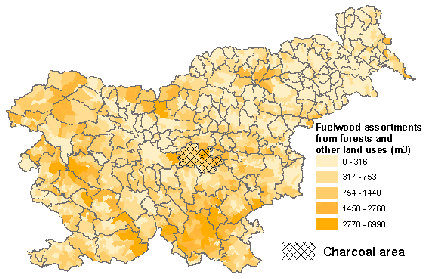


Why developing the Slovenia WEIS ?
Before the Project, a holistic picture of the wood energy sector was not available. The existing information relevant to this topic, sometimes very interesting and accurate, was fragmented and failed to provide a coherent appreciation of the relevance of this sector in both forestry and energy contexts. Moreover, this prevented the valuation of wood energy’s economic weight as a substitute to imported fuels, as an income generator in rural areas, and its environmental role as renewable fuel.
SWEIS was therefore needed in order to interconnect this mass of fragmented elements into a simple, comprehensive frame through which the wood energy sector may be analyzed and its multiple qualities and values perceived.
Filling-in the various SWEIS elements required some estimation processes based on existing data sources. Some are the results, aggregated at national level, of the WISDOM analysis and others are based on previous studies or statistics from the Slovenia Yearbook.
The following sections list the elements of SWEIS and describe the input data used. For the WISDOM-derived items reference is made to the previous Chapter while for the other elements a short description is given.
Fuelwood
From forests
Current and potential fuelwood from forests was based on the rich forest compartments database maintained by SFS [11]. National values are the summary of KO-level data reported in the WISDOM geodatabase.
From other land uses
The estimation of woody biomass from non-forest land uses was the result of a specifically designed survey which produced the first assessment ever done in the country. National values are the summary of KO-level data reported in the WISDOM geodatabase.
From industries
The amount of industrial wood residues was based on the studies done by SFI on the potential of woody biomass in Slovenia [5] [6] [10]. The best estimates of wood residue production referred to year 1995 for which a total amount of 722 000 m3 was estimated [10]. To estimate the production of wood residues up to year 2002 a relation was assumed between the production of residues and the total amount of industrial wood products, which are reported in the Slovenia Yearbook. The latter reported a steady annual decrease in the industrial wood production of some 3.7% and, accordingly, the 1995 production was reduced annually with the same rate.
Charcoal
The production of charcoal was rather limited and concentrated in the municipality of Litija in central Slovenia, as shown in Figure 18. Time series of charcoal production, import and total consumption provided by Mr. Prah, SFS, are summarized in Table 7.
Table 8: Charcoal statistics. Values in tons
1995 |
1996 |
1997 |
1998 |
1999 |
2000 |
2001 |
2002 |
2003 |
|
Production |
200 |
200 |
210 |
230 |
240 |
270 |
250 |
320 |
260 |
Import |
360 |
350 |
340 |
320 |
310 |
280 |
290 |
300 |
240 |
Export |
0 |
0 |
0 |
0 |
0 |
0 |
0 |
0 |
0 |
Consumption |
560 |
550 |
550 |
550 |
550 |
550 |
540 |
620 |
500 |
Figure 18: Charcoal production area in Slovenia: Litija Obcina. On background, distribution of the estimated current production of fuelwood assortments from forests and other land uses.

Black Liquor
Black liquor data was provided by the pulp and paper industry of Krsko, which is the only one operating in Slovenia. The annual production of black liquor corresponds to some 109 000 m3 of wood. The data source estimated that there was little variation in this value in the last decade; accordingly, the value in SWEIS was kept constant.
Fuelwood
Import of fuelwood was reported by the Slovenia Statistical Office [14]. Import of this item was minimal, ranging in the last few years around 1000 m3.
Charcoal
See table 8 above.
Black Liquor
No import of black liquor was reported.
Fuelwood
Export of fuelwood was reported by the Slovenia Statistical Office [14]. The amount annually exported is in the range of 60 000 m3. Main fuelwood exports are to Italy.
Charcoal
No export of charcoal was reported.
Black Liquor
No export of black liquor was reported.
Fuelwood
The estimation of fuelwood consumption in the household sector was a specific output of the WISDOM analysis, which was based on 2002 census of population, households, dwellings and buildings and other supporting references [8] [9] [13].
Charcoal
See table 8 above.
Black Liquor
No black liquor consumption was reported in the household sector.
Fuelwood
The amount of industrial wood residues consumed for non-household uses was based on the studies done by SFI [5] [6] [10]. The best estimation of the consumption of wood residues referred to year 1997 for which a total amount of 432 000 m3 was estimated [10]. More recent data was available for DHSs, CHPs and other boilers that provide heat and steam for industrial processes, many of which are located in the same wood industries that produce the residues. The recorded consumption of available references totaled some 391 000 m3 for year 2002. Unfortunately the available data set was not complete. In order to account, tentatively, for the missing data the consumption was estimated at some 500 000 m3 at year 200212.
Charcoal
No charcoal consumption in the industrial sector was reported.
Black Liquor
The entire consumption of black liquor takes place in the pulp and paper industry of Krsko that produces it.
12 Additional information on wood waste was generated by SFI after the completion of the WISDOM component of the Project (see Chapter “Project follow-up – WISDOM development”). However, since the response to the questionnaires sent out was not complete at the time of writing the estimated values were not replaced. Preliminary results seem to confirm the order of magnitude of the estimates used.